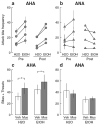GABA(A) receptors in the dorsal raphé nucleus of mice: escalation of aggression after alcohol consumption
- PMID: 20589493
- PMCID: PMC2992972
- DOI: 10.1007/s00213-010-1920-x
GABA(A) receptors in the dorsal raphé nucleus of mice: escalation of aggression after alcohol consumption
Abstract
Rationale: The dorsal raphé nucleus (DRN), the origin for serotonin (5-HT) in forebrain areas, has been implicated in the neural control of escalated aggression. Gamma aminobutyric acid type-A (GABA(A)) and type-B (GABA(B)) receptors are expressed in the DRN and modulate 5-HT neuronal activity, and both play a role in the behavioral effect of alcohol.
Objective: The purpose of this study is to examine the interaction between drugs acting on GABA receptors in the DRN and alcohol in their effects on aggressive behaviors.
Method: Male CFW mice, housed with a female, were trained to self-administer ethanol (1.0 g/kg) or water via an operant conditioning panel in their home cage. Immediately after they drank either ethanol or water, the animals were microinfused with a GABAergic drug into the DRN, and their aggressive behaviors were assessed 10 min later. Muscimol (0.006 nmol), a GABA(A) receptor agonist, escalated alcohol-heightened aggression but had no effect in the absence of ethanol. This effect of muscimol was prominent in the animals that showed alcohol-heightened aggression, but not the animals that reduced or did not change aggressive behavior after ethanol infusion compared to water. On the other hand, the GABA(B) agonist baclofen (0.06 nmol) increased aggressive behavior similarly in both water and ethanol conditions. Antagonists of the GABA(A) and GABA(B) receptors, bicuculline (0.006 nmol) and phaclofen (0.3 nmol) respectively, did not suppress heightened-aggressive behavior induced by ethanol self-administration.
Conclusion: GABA(A) receptors in the DRN are one of the neurobiological targets of alcohol-heightened aggression. Activation of the GABA(B) receptors in the DRN also produced escalated aggression, but that is independent of the effect of alcohol.
Figures




Similar articles
-
Behavioral characterization of escalated aggression induced by GABA(B) receptor activation in the dorsal raphe nucleus.Psychopharmacology (Berl). 2012 Nov;224(1):155-66. doi: 10.1007/s00213-012-2654-8. Epub 2012 Mar 7. Psychopharmacology (Berl). 2012. PMID: 22395428 Free PMC article.
-
Infralimbic and dorsal raphé microinjection of the 5-HT(1B) receptor agonist CP-93,129: attenuation of aggressive behavior in CFW male mice.Psychopharmacology (Berl). 2012 Jul;222(1):117-28. doi: 10.1007/s00213-011-2629-1. Epub 2012 Jan 7. Psychopharmacology (Berl). 2012. PMID: 22222863 Free PMC article.
-
Differential regulation of 5-hydroxytryptamine release by GABAA and GABAB receptors in midbrain raphe nuclei and forebrain of rats.Br J Pharmacol. 1996 Dec;119(7):1375-84. doi: 10.1111/j.1476-5381.1996.tb16049.x. Br J Pharmacol. 1996. PMID: 8968546 Free PMC article.
-
GABA(B) receptor modulation of serotonin neurons in the dorsal raphé nucleus and escalation of aggression in mice.J Neurosci. 2010 Sep 1;30(35):11771-80. doi: 10.1523/JNEUROSCI.1814-10.2010. J Neurosci. 2010. PMID: 20810897 Free PMC article.
-
Escalated aggression after alcohol drinking in male mice: dorsal raphé and prefrontal cortex serotonin and 5-HT(1B) receptors.Neuropsychopharmacology. 2008 Nov;33(12):2888-99. doi: 10.1038/npp.2008.7. Epub 2008 Feb 27. Neuropsychopharmacology. 2008. PMID: 18305458
Cited by
-
Effects of cocaine history on postsynaptic GABA receptors on dorsal raphe serotonin neurons in a stress-induced relapse model in rats.Eur Neuropsychopharmacol. 2016 Jan;26(1):45-54. doi: 10.1016/j.euroneuro.2015.11.009. Epub 2015 Nov 21. Eur Neuropsychopharmacol. 2016. PMID: 26640169 Free PMC article.
-
Interactions between Lateral Hypothalamic Orexin and Dorsal Raphe Circuitry in Energy Balance.Brain Sci. 2024 May 7;14(5):464. doi: 10.3390/brainsci14050464. Brain Sci. 2024. PMID: 38790443 Free PMC article.
-
Behavioral characterization of escalated aggression induced by GABA(B) receptor activation in the dorsal raphe nucleus.Psychopharmacology (Berl). 2012 Nov;224(1):155-66. doi: 10.1007/s00213-012-2654-8. Epub 2012 Mar 7. Psychopharmacology (Berl). 2012. PMID: 22395428 Free PMC article.
-
The Sturm und Drang of anabolic steroid use: angst, anxiety, and aggression.Trends Neurosci. 2012 Jun;35(6):382-92. doi: 10.1016/j.tins.2012.03.001. Epub 2012 Apr 18. Trends Neurosci. 2012. PMID: 22516619 Free PMC article. Review.
-
Infralimbic and dorsal raphé microinjection of the 5-HT(1B) receptor agonist CP-93,129: attenuation of aggressive behavior in CFW male mice.Psychopharmacology (Berl). 2012 Jul;222(1):117-28. doi: 10.1007/s00213-011-2629-1. Epub 2012 Jan 7. Psychopharmacology (Berl). 2012. PMID: 22222863 Free PMC article.
References
-
- Addolorato G, Leggio L, Abenavoli L, Agabio R, Caputo F, Capristo E, Colombo G, Gessa GL, Gasbarrini G. Baclofen in the treatment of alcohol withdrawal syndrome: a comparative study vs diazepam. Am J Med. 2006;119:276–278. - PubMed
-
- Aguayo LG. Ethanol potentiates the GABAA-activated Cl− current in mouse hippocampal and cortical neurons. Eur J Pharmacol. 1990;187:127–130. - PubMed
-
- Allan AM, Harris RA. Involvement of neuronal chloride channels in ethanol intoxication, tolerance, and dependence. Recent Dev Alcohol. 1987;5:313–325. - PubMed
-
- Arikan R, Blake NM, Erinjeri JP, Woolsey TA, Giraud L, Highstein SM. A method to measure the effective spread of focally injected muscimol into the central nervous system with electrophysiology and light microscopy. J Neurosci Methods. 2002;118:51–57. - PubMed
Publication types
MeSH terms
Substances
Grants and funding
LinkOut - more resources
Full Text Sources

